Statue of Christopher Columbus in Spain
Christopher Columbus certainly ranks as one of the greatest men of achievement the world has ever known, and also justly one of the most renowned, for the entire history of Europeans in America originated from his vision, religious sense and adventurous spirit. As can be expected in a man with an impassioned nature, many controversies have arisen, but all students of his voyages relate he sincerely believed that almighty God had chosen him to discover portions of the world hitherto shrouded in mystery. And his success, after years of struggle and suffering, lends credence to the historical reality of that statement.
Pope Leo XIII summed it up best in an encyclical of tribute on the Quadricentennial of Columbus’ great discovery. The Pontiff recognized that he sought the improvement of human society through knowledge, “nor did he despise glory . . . an ideal to great souls, nor did he scorn a hope of advantage to himself.” But along with human desires was the consideration of Christianity that provided “him with the strength of mind and will…and consoled him in the midst of the greatest difficulties.” But his overriding motivation was “to open a way for the Gospel over new land and seas.” In short, America was discovered
by a Catholic missionary.
The Man
Born Christoforo Colombo (Cristóbal Colón in Castilian, the language of his choice) in the Italian port city of Genoa in 1451, the young mariner went to sea at fourteen and spent the rest of his life either on the ocean or in some maritime-related business. Although the alert seaman had little formal education, he easily mastered navigation, geometry, astronomy, geography and map-making, and later in life became competent in Latin. He studied the Renaissance scholars, Aeneas Sylvius Piccolomini, eventually Pope Pius II and Pierre (Cardinal) d’Ailly and corresponded with the Florentine intellectual, Paolo Toscanelli who numbered Da Vinci among his circle of friends, all of whom advocated sailing west from Europe into the unknown to engage in Oriental exploration.
Columbus sharpened his extraordinary skills of seamanship while sailing under the Portuguese flag during the vibrant, exciting days that inaugurated the Age of Discovery. His nautical apprenticeship coincided with the advance of technology as the Portuguese persistently pushed their way down the West coast of Africa to locate an eastern route to India. He breathed in the exuberant air of discovery that instilled in him an ambition to extend the limits of Christendom, but in the opposite direction.
Dispute among cosmographers. Painted by José Antônio da Cunha Couto for the celebrations of the 4th centenary of the discovery of the Americas. The painting shows Pedro Álvares Cabral, kneeling with a portfolio in his hands. At the background, from left to right, Christopher Columbus, Vasco da Gama and Amerigo Vespucci.
The turbulent and reckless times added to Columbus’ emotional maturity. Danger from the constant warfare of the petty states that rimmed the Mediterranean and from the ever-present Moslem corsairs developed in the sea captain that imperturbable courage and perseverance that marked all his great moments. More importantly, these natural virtues were augmented by a deep understanding of the supernatural that can only come from prayer and reflection. Columbus was fully cognizant of the inadequacy of human resources to sustain himself in the various ordeals he had to endure and the absolute necessity of the grace that he merited from his frequent Communion, canonical daily office and other devotions.
Christopher Columbus, having been told that discovering the Americas was no great accomplishment, challenged his critics to make an egg stand on its tip. After his challengers gave up, Columbus did it himself by simply tapping the egg on the table so as to flatten its tip.
In short, the pious and fervent explorer, who became a third-order Franciscan friar while in Spain, could be considered a seagoing monk with much in common with the great religious military orders of the period.
The Mission
The vision of his vocation was deeply etched in his mind in 1479 when he married into a prominent Portuguese family that owned property in Lisbon and on Madeira. His unsuccessful efforts to interest the king in his voyages, his correspondence and his refusal to settle down to a life of comfortable mediocrity, all indicate his unswerving adherence to the call of Divine Providence regardless of whatever suffering it might entail. After the death of his first wife and his failure to obtain assistance from King Joao II, Columbus and his five-year-old, Diego, sailed to Spain, landing at the little sleepy seaport of Palos on the Atlantic.
Christopher Columbus at the gates of the monastery of Santa Maria de la Rabida with his son Diego. Painting by Benito Mercade y Fabregas
Once again monastic life, the backbone of the Church, proved to be a great asset to Western Civilization. Having arrived in a strange country, penniless and without any support, afflicted by compounding disappointments, Columbus reached out for the hand of God. He and his little boy, hungry and thirsty, trekked to the Franciscan monastery of La Rabida outside of town where they were received with bountiful generosity. Through the influence of the provincial, Columbus was placed in contact with several noblemen who in turn introduced him to the Most Catholic Monarchs, Ferdinand and Isabella.
During this period, Columbus married for the second time. Several historians, including some prominent Catholics, have claimed that his relationship with the mother of his second son, Fernando, was illicit, based on some ambiguous language in his last will and the absence of a marriage certificate. But we should not carelessly compromise the Franciscan tertiary’s otherwise superior moral conduct. Since he moved freely among the most respectable elements in both lay and ecclesiastical society, this gratuitous calumny appears unlikely. Moreover, the cause of his canonization was opened in 1877 through the support of Pope Pius IX, who himself has been beatified. Revolutionary ferment in France quickly smothered the process because the thought that America had been discovered by a saint was intolerable.
Detail of the monument to Christopher Colombus at the Plaza de Colón in Madrid, built between 1881 and 1885. Relief shows Queen Isabella offering to pawn her jewels in aid of Columbus' enterprise. At the right, a prayer kneeler with a crucifix.
Delays and disappointments followed on obstacles and difficulties. Although Queen Isabella was impressed by the noble bearing and eloquence of the experienced navigator, her mind was occupied with other problems, principally the expulsion of the Moors from their last stronghold on the Spanish peninsula, the Emirate of Granada. Distressed beyond endurance and unable to provide subsistence for himself, much less for his two sons, Columbus decided to pick up Diego, now twelve, at La Rabida and leave Spain.
The prior, Father Juan Perez, who had been the Queen’s confessor, convinced of the weary traveler’s ability and piety, sent a formal request asking her to reconsider, which she did. This resulted, after further and often harrowing negotiations, in her complete support. She located the money for three ships and ordered the seaport of Palos to provide men for the crew.
King Ferdinand and Queen Isabella bid farewell to Columbus for his First Voyage, Departure for the New World, August 3, 1492.
Fear of such an unheard of adventure struck the hearts of the town’s sailors with foreboding. Once again, Father Perez came to the rescue by enrolling the area’s leading mariners, the Pinzon brothers, along with their caravel, the Pinta, in the mission and using his Franciscan influence to instill confidence in the townspeople. Columbus spent much of his time praying in his cell, waiting for a favorable wind.
At three o’clock in the morning on August 3, 1492, Admiral Columbus received Holy Communion, rode to town with Father Perez and received his parting benediction. The Admiral climbed aboard the quarterdeck and ordered the sails to be unfurled, beginning the voyage that changed world history. He then went below and made the first entry in the ship’s log, “In nomine Domini nostri Jesu Christi.”
A replica of the Santa María, Columbus’ flagship in 1492 seen in the harbour of Funchal, Madeira.
The Discovery
From the very beginning of the voyage, fear and discontent ran through the crew, for no ship had ever sailed into the Sea of Darkness, leastwise that returned to tell about it. At specified times during the day, Columbus remained in his cabin to make his meditation and recite the Divine Office, and the rest of the time he spent on the quarterdeck sleeping very little. Every evening the eternal silence was broken by the sounds of the Salve Regina and the Ave Maris Stella. As the days dragged on, discouragement and fear increased. Only the dignified, noble bearing of the powerfully built navigator maintained discipline, but, nevertheless, on October 10 the men had reached the breaking point. Under extreme duress, the Admiral’s eloquent certainty (he had been watching flocks of land birds flying across in the distance) bought him three more days. On October 12 at two o’clock in the morning, in the light of the newly risen moon, a sailor on the Pinta saw land.
Later in the morning, the Admiral went ashore to claim the island for his Spanish sovereigns and dropped to his knees to thank Our Lord for His infinite mercy, and in His honor named it San Salvador—Holy Savior (usually identified with Watling Island in the Bahamas). He also claimed the island and all subsequent discoveries for Christianity and noted in his log that the friendly, docile natives would make excellent converts. Modern sensibilities may cringe at the idea of Europeans placing discovered land and people under royal and ecclesiastical authority, but Columbus was just transferring the rules of the day to the New World. A Christian state had the right to proclaim sovereignty over heathen and infidel domains. The Catholic monarchs exercised a similar prerogative over Granada and so did John Cabot in Newfoundland, Jacques Cartier in the St. Lawrence Valley and Henry Hudson in New York harbor, among others.
Christoper Columbus arrives in America. Painting by by Gergio Deluci
Columbus spent several days cruising through the Bahamas, explored the northeast coast of Cuba and crossed the Windward Passage to make contact with a large group of friendly Indians on the Haitian coast of Hispaniola. There on Christmas Day, the Santa Maria ranaground on a treacherous coral reef through the ineptitude of an insubordinate pilot and had to be abandoned. The sailors stripped the vessel of its valuable wood that was used to build La Navidad, the first European settlement in the New World. Leaving most of the shipwrecked crew behind as its residents, Columbus warned them not to partake in the vices of the natives, and sailed off to the east and Spain.
Immediately upon his return to Spain, the Admiral marched in solemn procession to the monastery at La Rabida where Father Perez said a Mass of thanksgiving and chanted a Te Deum. Throughout Spain for the next few weeks, Columbus heard nothing but cries of joy and praise. But he was to hear the sound of celebration no longer, only the haunting cries of misfortune and disappointment.
Second Voyage
Isabella sent the Admiral back to the Indies with a much expanded fleet of 17 ships and 1,500 men. Added to the original goals of making discoveries and spreading the Gospel were instructions to colonize. Columbus made landfall in the southeast Caribbean in the island chain of the Lesser Antilles and came in contact with the fierce Caribs for the first time. No primitive people have ever carried the eating of human flesh to such disgusting depths. The Caribs from which our word “cannibal” is derived actually raised children for roasting much the same as farmers raise steers. After working his way up the island chain, he finally reached the colony of La Navidad on Hispaniola. He discovered to his grief that the entire garrison had been murdered. Investigation revealed that passions, lust and general misconduct led to the slaughter.
The return of Christopher Columbus;his audience before King Ferdinand and Queen Isabella. Painting by Eugene Delacroix
Columbus laid out a new town called Isabela, appointed a council to rule, and set out to do that for which he was best suited: navigate and explore. For five months, he cruised off the coasts of Cuba and Jamaica in a remarkable voyage that demonstrated his superior talent for piloting under exceedingly difficult conditions. On his way to Puerto Rico, the Admiral succumbed to a condition that resembled what some would call today a nervous breakdown, caused by extreme exertion, improper diet and lack of sleep. The first evidence that he was suffering from arthritis compounded his afflictions.
Muelle de las Carabelas (Harbour of the Caravels) is a waterfront exhibition with life-size replicas of Columbus's three ships: the Niña, the Pinta and the Santa María, built for the 500th anniversary celebrations in 1992. The museum has details of Columbus's life, including this exhibit.
The ailing navigator returned to Isabela and walked into a hornet’s nest of intrigue and rebellion. Against his orders, a large group of adventurers were ravishing the Indians. An understandable reaction from the latter had plunged the island into warfare. Tired and sorrowful, Columbus returned to Spain. When he left his cabin upon arrival, he was wearing his brown Franciscan habit, and his face showed the marks of a man who had aged greatly.
Last Voyages and Death
The Caribbean operation was taken over by professional soldiers, capable but turbulent men, and trained bureaucrats who were motivated by securing a good return on Spain’s investment. Columbus had planned for a permanent settlement for the transfer of Hispanic culture and Catholic principles to the newly discovered land. That conflict of priorities produced most of the troubles that fell so heavily on the courageous idealist.
On his third voyage in 1498, Columbus navigated even farther south where he discovered Trinidad and laid eyes for the first time on the American Continent at Venezuela. When he returned to his home base on Hispaniola, now located at Santo Domingo, he found the island in turmoil as usual. This time he applied stricter justice and hung a few of the troublemakers. Meanwhile Columbus’ enemies had caused sufficient doubt in the great Admiral’s ability to govern to have a royal commissioner sent to investigate. When the Admiral appeared obediently before the commissioner, he slapped Columbus in jail. Loaded with chains and wasted by disease and acute pain, the Discoverer of the New World was sent home to Spain.
During the fourth voyage (1502–1504), an attempt to find the nonexistent passage through the discovered lands to India, Columbus enjoyed having his son, Fernando, now fourteen, with him. However, little else succeeded for he experienced an unrelieved series of terrible storms, murderous Indians and the constant threat of disaster from worm-eaten ships that were literally rotting beneath them. After sailing along the coast of Central America for several months, the harried navigator was forced to beach his two remaining caravels (of the original four) on the island of Jamaica where he was marooned for seven months. A bloody mutiny and a miraculous rescue followed.
Finally Columbus arrived back in Spain, broken in health and fortune, at the end of 1504. Three weeks later, Queen Isabella died and in her grave with her lay buried any hope for earthly reward, for Ferdinand never completely fulfilled his promises. But that mattered very little because the great Discoverer, wearing the brown habit of Saint Francis and surrounded by his two sons and a few Franciscans, breathed his last eighteen months later with the chains of his third voyage hanging on the wall.
The death of Columbus. Lithograph by L. Prang & Co., 1893.
by Jeremias Wells
____________________________
Bibliographical Note:
Two books by Samuel Eliot Morison contributed greatly to the story of Columbus: Admiral of the Ocean Sea (Boston, 1942) and The European Discovery of America: The Southern Voyages (New York, 1974).
Short Stories on Honor, Chivalry, and the World of Nobility—no. 116

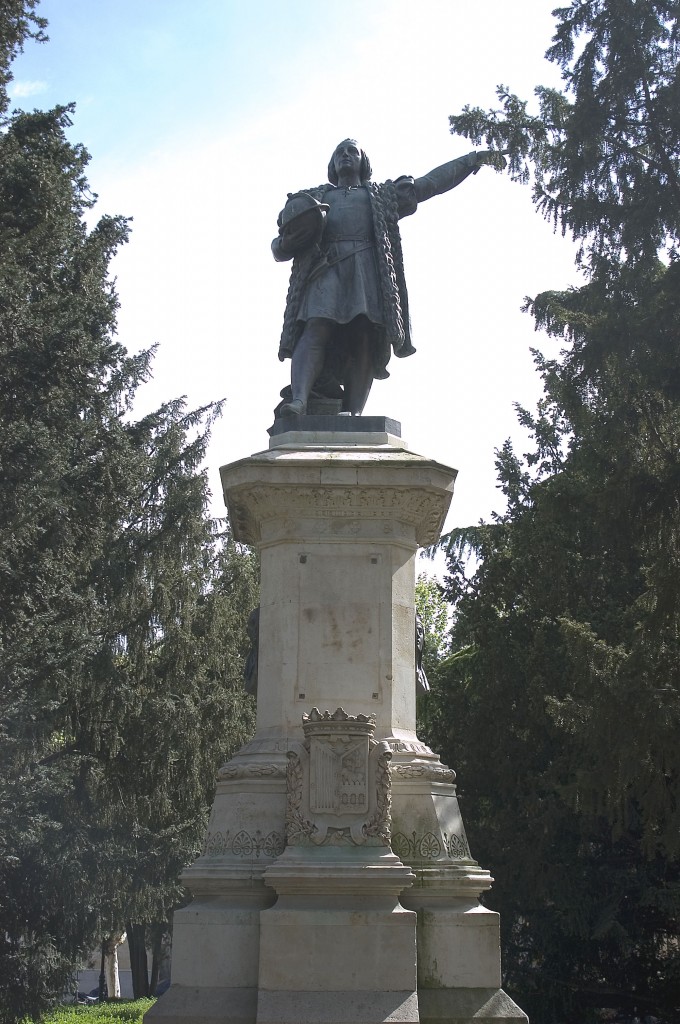


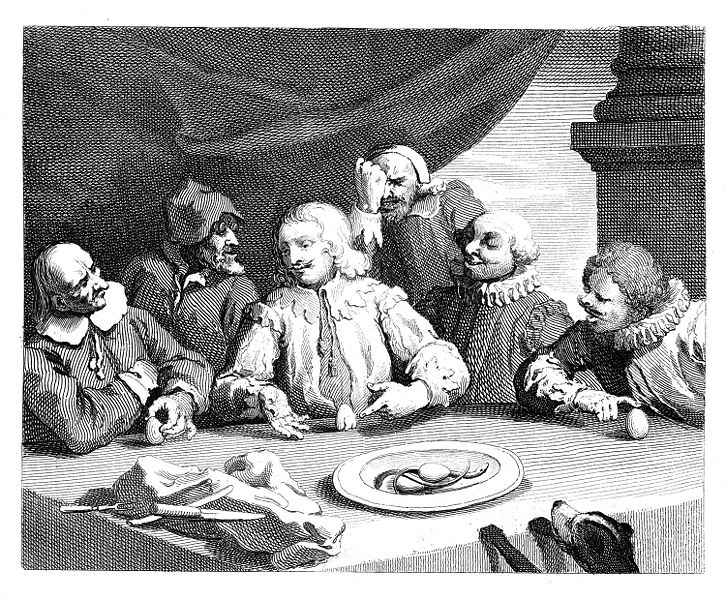
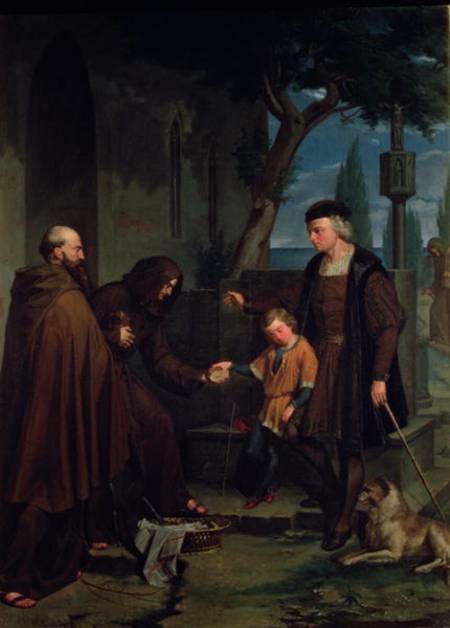
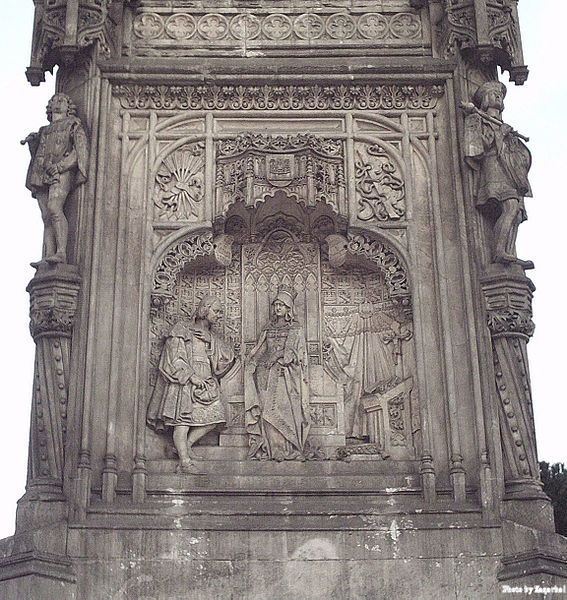
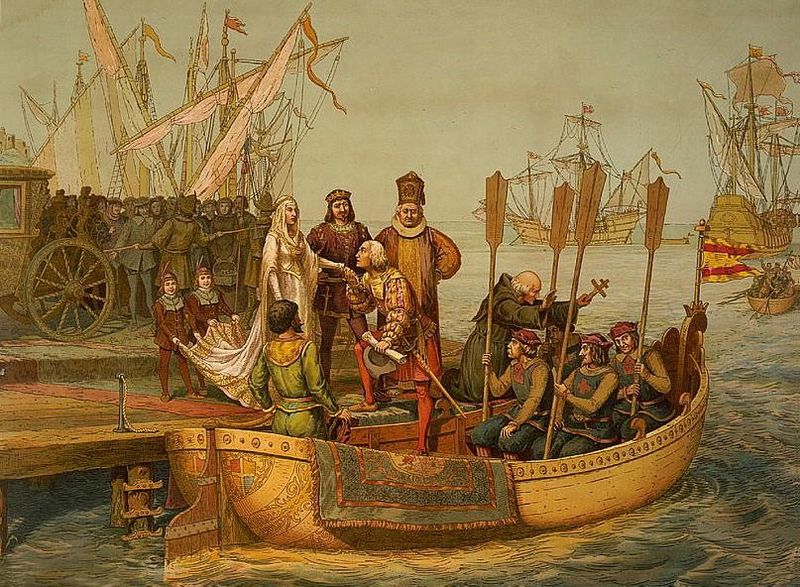
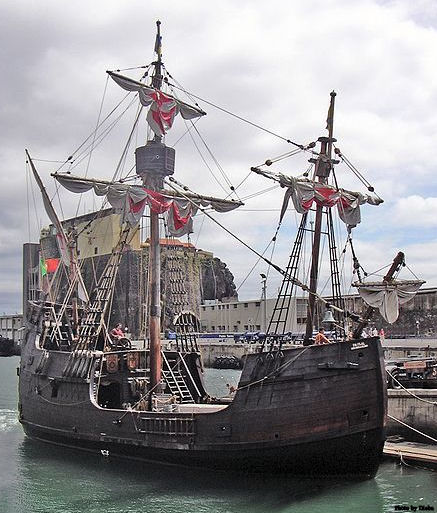



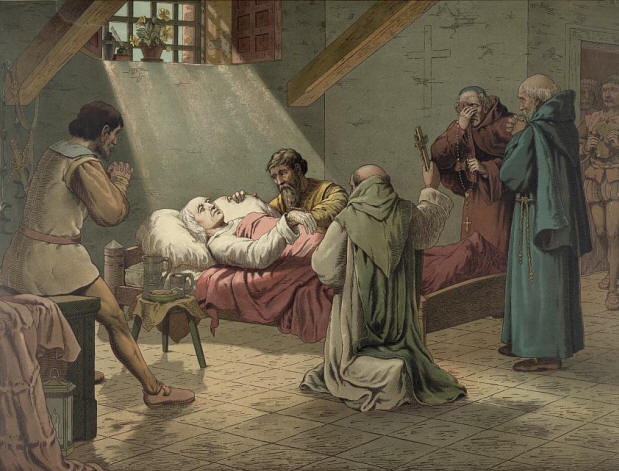
FINALLY!! I've been looking long and hard for the Catholic perspective on Columbus. Especially after I was attacked in a public library by a librarian and fellow parishioner, when I informed her that I wanted to teach my young children about Columbus...I knew that this was revisionist history, but I've heard it repeated so many times, I was beginning to lose hope that even the morally non-descript Christopher Columbus that I grew up learning about would be forgotten.
ReplyDeleteThank you Thank you Thank you!!!
teachers don't teach students about the untold part of Columbus they just tell the good part of him but no he really did not discover america
ReplyDeletecolumbus was bad but he gave us a break from work/school
ReplyDelete